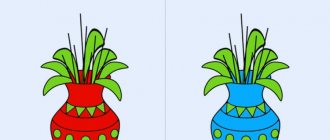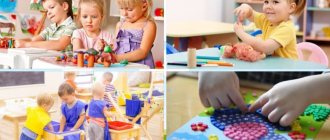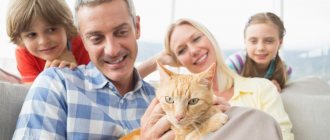Didactic games on the topic “Pets”
Transcript
1 Didactic games on the topic “Pets” “What will he give us?” (“What benefits do pets bring?” Goal: Development of logical thinking, teaching children to construct statements and reasoning. What will the cow give us? Milk, sour cream, cottage cheese, cheese, meat, skin. What will the pig give us? Meat, lard, skin. What will the goat give us? Meat, milk, six, cheese. What will the sheep give us? Wool, meat, skin. What will the rabbit give us? Fur, meat. What will the horse give us? You can ride a horse and carry loads. Meat, skin. What will chickens, geese, and ducks give us? Eggs, meat, feathers and fluff. “What does a livestock farmer feed his animals?” (“What Do Pets Eat”) Purpose: Development of memory and logical thinking. The horse is fed oats and grass. Goats, sheep, cows, rabbits are fed with grass by the Lost and Found Bureau (Cut-out pictures) Goals: Development of visual attention. Formation of logical thinking and phrasal speech. Cut cards with The teacher shows the children cards depicting parts of the animal's body. Children determine who lost it: This is the tail, the cow lost it. And these are the paws, the puppy lost them.
2 “What animals are hidden in the picture?” Goal: Development of attention, thinking, imagination. Cards with Invite the child to find and name the animals drawn in the picture. “Guess the animal by description” Goal: Developing the ability to describe animals and recognize them by description. Cards with Game progress: The teacher gives the children cards with Children do not show their cards to anyone. The teacher invites one child to describe the animal depicted in his picture, or to make a riddle about it. Other children must guess what kind of animal it is. “Collect a picture” Goal: Development of logical thinking, outlook, cognitive interest and speech activity. Cards with images of animals, cut into several parts. Progress of the game: Children are given game cards cut into 2, 3, 4 parts (in accordance with the age and abilities of the child). Having collected the picture, the child tells what animal he collected.
3 “Who will be who?” (“Who was who?”) Goal: Development of logical thinking, cognitive interest and speech activity of children. Cards with pictures of pets with babies. Progress of the game: The teacher asks the children, Who will be who when they grow up? Who was who? The foal will be (horse), The lamb will be (sheep, ram), The kid will be (goat, goat), The calf will be (cow, bull), The piglet will be (pig), The little rabbit will be (rabbit), Purpose: Development of attention, thinking, Imagination , the ability to compare objects by presentation. Cards with Game progress: Invite the child to find and name the animals drawn in the picture. “Whose silhouette?” Game "Who's the boss?" Goal: Development of visual attention. Formation of logical thinking and phrasal speech. Cards with images of animal body parts.
4 Progress of the game: the teacher shows pictures with parts of animals, you need to answer the questions “Whose tail?”, “Whose head?”, “Whose horns?”, “Whose hooves?”, “Whose udder?”. Game "Gather the Family." Goal: Formation of logical thinking and phrasal speech. Formation of new words from different stems. Cards with Game progress: on the table there are pictures depicting animals living on a farm and pictures depicting baby animals - Place the animals of the same family next to each other and tell who is standing next to whom. “Give me a word” Purpose: To consolidate the names of domestic animals and their cubs. Learn to construct reasoning statements. Forming plural nouns Pictures of pets. Progress of the game: Herd (many horses), Herd (many cows), Flock (many sheep), Pack (many dogs). “Who is which?” Goal: Consolidate knowledge about domestic animals and their cubs. Develop coherent speech. Pictures of pets. Progress of the game: You need to choose a sign for the nouns.
5 The foal is small, helpless, timid, defenseless, weak, cute. The puppy is playful, lively, active, curious, angry. The kid is stubborn, timid, beautiful, affectionate, gray. The pig is playful, pink, fat, cheerful, small, funny. The little rabbit is long-eared, gray, fluffy, funny, timid. The lamb is white, timid, cowardly, curly, fluffy, cute. The calf is affectionate, stubborn, playful, clumsy, and playful. “Tell about a pet” Goal: Consolidate knowledge about domestic animals and their babies, develop children’s communication skills, teach them to write a coherent story based on a series of pictures. reference picture Game progress: Make up a descriptive story about the animal based on the plan picture.
Didactic games for middle-aged children on the topic: “Wild Animals”
Description:
“Didactic games for middle-aged children on the topic: “Wild Animals”
Author of the project : Rappo Elena Rudolfovna, teacher of the State Budgetary Educational Institution kindergarten No. 2 of a combined type in the Petrodvortsovo district of St. Petersburg.
Goal: Consolidate and generalize children’s ideas on the topic “Wild Animals” using Mimio tools.
The project was created using Mimio interactive technologies and can be used by kindergarten teachers in classes on social, communicative and cognitive development, as well as in individual work.
The project is aimed at preschool children aged 4-5 years.
Tasks:
Educational:
- To consolidate children's ideas about the wild animals of our region, their way of life, and nutrition.
- Fix the names of the cubs.
- Strengthen your ability to use Mimio tools.
Educational:
1. Develop cognitive interest.
2. Develop attention, memory, perception, logical thinking.
3. Develop fine motor skills and spatial orientation.
Educational:
1. Develop communication skills.
1 page - Title page
Page 2 - Contents with hyperlinks to pages with games.
The content is presented in the form of a list with game names. When you click on the picture of a green leaf or a task grouped with it, you will follow a hyperlink to the page with the game.
Page 3 – Game “Find the shadows of animals”
The game is aimed at developing attention and visual perception.
Children are asked to find the shadow of the animal and check by matching the shadow with the picture. Shadows are superimposed on the picture.
Page 4 – Game “Find who is the odd one out”
The game promotes the development of thinking and the ability to generalize.
Children are asked to find the extra animal. Click on the picture: if the answer is correct, a tick appears, if the answer is incorrect, a cross appears.
Page 5 – Game “Find a Pair”
The game promotes the development of attention and memory.
Children are asked to find paired pictures of animals. Animals are hidden under the gallery object - green stars, which when clicked disappear with sound.
Page 6 – Game “Recognize by Voice”
The game develops auditory perception.
Children are invited to listen to sound files by clicking on the corresponding icon. The answers are under the red and blue bubbles gallery object.
Page 7 – Game “Find the Animals”
The game promotes the development of attention and observation.
Children are invited to find hidden animals against the background of the forest, name them and pull them out of hiding.
Page 8 – Game “Put into baskets”
The game helps to consolidate ideas on the topic.
Children are asked to place their squirrels and hedgehog food in baskets. If you choose incorrectly, the picture remains in front or behind the basket. If you choose correctly, the picture goes inside the basket.
Page 9 – Game “Color the forester’s new house”
The game helps to consolidate colors and geometric shapes.
Children are invited to color a house made up of geometric shapes using the palette and fill tools.
Page 10 – Game “Assemble the puzzle and check”
The game promotes the development of a holistic perception of the subject and fine motor skills.
Children are asked to make a picture out of four parts. By clicking on the gray curtain, you can check whether the task was completed correctly by comparing it with the thumbnail image.
Page 11 – Game “Find with a flashlight”
The game develops attention and spatial orientation.
Children are invited to use a beam to find all the animals in the night forest. You can check by clicking on the gray triangle.
Page 12 – Game “Find the differences and check”
The game helps develop the ability to compare pictures, find their similarities and differences.
Children are asked to compare two pictures and find five differences. You can check whether the task was completed correctly by clicking on the gray triangle.
Page 13 – Game “Count, check with a magnifying glass”
The game is aimed at developing attention and strengthening counting skills.
Children are asked to count mushrooms, acorns, and nuts. Check their quantity with a magnifying glass.
Page 14 – Game “Count. The owl will check"
The game is aimed at strengthening knowledge of numbers and counting skills.
Children are asked to count the number of animals. Passing the picture through the image of an owl, light green numbers will appear on the dark green background on the right.
Page 15 – Game “Labyrinth. Help me find the cub"
Promotes the development of attention, fine motor skills, visual-spatial orientation.
Children are asked to guide the hare through the maze to her baby. Using the pencil and palette tools, draw a path. By clicking on the gray triangle, you can open the test area.
Page 16 – Game “Guess who lives where”
The game develops the ability to classify.
Children are asked to arrange pictures of domestic and wild animals in accordance with the picture. You can check yourself by clicking on the gray triangle.
Page 17 – Game “Guess the riddles”
The game is aimed at developing logical thinking and coherent speech.
Children are asked to guess four riddles. Under each riddle there is an answer picture; when you click on the colored rectangles, the animation fades and the answer picture appears.
Page 18 – Game “Help the cubs find their parents”
Children are asked to drag pictures of babies to their parents and name them. You can check yourself by clicking on the gray triangle. A test area will appear.
Page 19 – Game “Help the wolf find the right shadow”
Develops attention, observation, visual perception.
Children are asked to find the correct shadow from the four offered. By clicking on the picture, if the answer is correct, you will receive a tick, and if the answer is incorrect, you will receive a cross.
Page 20 – Game “Pick raspberries for the bear”
The game promotes the development of fine motor skills, consolidation of counting skills and knowledge of numbers.
Children are asked to roll a six-sided die - the object of the gallery - and clone raspberries according to the number.
Page 21 – Continue the Sequences Game
The game develops attention and logical thinking.
Children are asked to continue the two sequences by inserting the corresponding animal pictures. Pictures are cloned.
Page 22 – Game “Find the predatory animals”
Children are asked to find predatory animals. By clicking on the picture, a tick appears if the answer is correct, and a cross appears if the answer is incorrect. The game helps to consolidate ideas on the topic.





